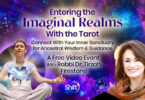 July 13th, 2021
July 13th, 2021
By Lissa Rankin, MD
Guest writer for Wake Up World
When I was posting recently on Facebook about dissociation, polyvagal theory, and developmental trauma, a conversation arose among those commenting about empathy- and what can block it. Words like narcissism, sociopathy, and autism floated around- and it was obvious that there were some triggers arising among those who have been wounded by other people’s absence of empathy in the face of painful emotional territory. What surprised me is that only a very few people touched upon the idea that those with the greatest sensitivity to other people’s painful emotions (the ones who might identify as “empaths”) can be the most insensitive of the bunch- not through any fault of their own, but as a side effect of trauma. So let’s unpack that for a bit…
[pro_ad_display_adzone id=”110028″]
Highly Sensitive People and Empathy
Why might a hypersensitive empath lack empathy and sensitivity? Well, think about it. If you’re an emotional sponge who picks up on other people’s feelings without clear, solid psychic boundaries that protect your energy field from the energy field of others, an angry, grieving, terrified, disappointed, or jealous person might hit you like a ton of bricks and overwhelm your nervous system, thrusting you into either a dorsal vagal “freeze” state or a sympathetic “fight or flight.” If you don’t know how to separate your feelings from someone else’s feelings, if what you call empathy is more like emotional contagion, catching other people’s emotions like a virus, this kind of emotional contagion can make you feel painfully uncomfortable and dysregulated. And what do we do when we put a hand on a hot stove? We understandably pull away. Or we try to make the stove not hot. Or we yell at the stove.
Between humans, that kind of pulling away, fixing, or lashing out can look insensitive- the opposite of what someone in pain needs. If I’m justifiably sad, angry, disappointed, or scared- and you withdraw from me, try to fix me so I’m no longer feeling those emotions, or lash out at me because you don’t like how you feel inside, that is likely to make me feel even worse. It doesn’t feel like empathy; it feels like the opposite.
The Art of Empathy
So what is healthy empathy? In the The Art of Empathy, Karla McLaren unpacks the six aspects of empathy which I’ve synopsized here:
- Emotion Contagion: the ability to sense that someone is having an emotion that might call for you to respond to it.
- Empathic Accuracy: the ability to accurately identify and understand emotions, in yourself and in another.
- Emotion Regulation: the ability to work with your emotions without being overtaken, stressed out, or frozen by them.
- Perspective Taking: the ability to ask, “What’s it like to be you?” and to see through someone else’s eyes.
- Concern for Others: which might seem obvious, but if you don’t care what it’s like to be someone else, you won’t behave in ways that will be perceived by the other as empathic.
- Perceptive Engagement—the PhD level of empathy. Perceptive engagement allows you to make decisions based upon your empathy, and to respond to someone else’s intense emotion in a way they perceive as care.
Perceptive engagement is a healing presence. If you can respond in a way that feels empathic to the one emoting, if you can create feelings of safety when someone feels vulnerable, helpless, scared, and isolated, you’re a healer—whether you’re putting your hands on someone’s body, making someone’s cappuccino, or cutting their hair.
Why Some Healers Might Struggle With Too Much Empathic Contagion
Unfortunately, because of their own boundary wounding trauma, many people who hang up a shingle and call themselves empaths, psychics, intuitives, or healers do just the opposite. Those who identify as empaths- who often carry high levels of developmental trauma- may try to shut down your emotions before you can even pop out a tear or vent some anger—so they don’t feel your pain so acutely in their own boundary wounded, hypersensitive nervous system. This can cause them to behave in ways that shut down your emotional release and lack empathy. Empaths might be good at emotion contagion or empathic accuracy, but because they often don’t know how to regulate emotion within themselves, they have a hard time getting all the way to real empathy.
I once saw someone who claimed to be a healer, whose writing I admired but whose empathy was clearly wounded, bring a person with stage-four cancer up on stage in front of a large group. After he peppered her with penetrating, boundary-violating questions and allegedly used his intuitive empath skills to point out her core wound, she started to cry. When her healing emotions started to flow while she told him the details of how she got hurt, he—no joke—cut her off and pretended to play a mini-violin in the most condescending way as he mocked her, saying, “Whadya want me to do? Play you a widdle sob song?” Her healing had started and stopped so abruptly that the audience was shocked, silenced in horror. Her shame spread through the room like motor oil on snow as our emotional contagion picked up on it. He was trying to “fix” her when what she needed was feeling and healing.
The Neurologic Distinction Difference Between Empathy and Compassion
While empaths may lack perceptive engagement, compassion can be cultivated by healing boundary wounding and taking advantage of the slight distance compassion offers in the presence of someone else’s pain. Empathy is neurologically distinct from compassion. Empathy means we feel WITH people. This means that when someone is happy, excited, or joyful, our brains respond as if something wonderful has happened- in us. Conversely, if we are empathizing with someone who is in pain, it lights up the pain centers in our brains. The more we lack the distinction of self/other, perhaps because of boundary wounding in childhood, the more someone else’s pain feels like our own pain, which might cause people to withdraw, fix, defend, or lash out. For those with the rare condition mirror touch synesthesia, this tendency is exaggerated. For those with mirror touch synesthesia, if you touch your cheek, they feel as if a hand is pressing against their own cheek, and if you get punched in the stomach, their own bellies may ache. At its most extreme, which has been observed in twins, when one twin is injured, the other twin may experience the exact same wound, even though they did not get injured.
As you can imagine, if you felt someone else’s emotional or physical pain as if it were your own, you might feel desperate to make their pain go away—so you would feel better. Unfortunately, this is not an impulse that helps others heal or makes others feel better or feel loved; it’s a self-protective impulse that can feel like the opposite of empathy to someone else who is in pain.
Compassion is not feeling WITH someone; it’s feeling FOR someone. Neurologically, it lights up our love centers more than our pain centers, so you might say it’s neurologically easier on us. In an article that distinguishes between the two neurologically, Tania Singer PhD and Olga Klimecki PhD report that compassion elicits feelings of warmth, concern, and care for others, as well as a strong inclination to ease the suffering and improve the wellbeing of others, whereas empathy with someone in pain feels painful to the one empathizing. As such, empathy can lead to burnout, especially among healers and empaths who spend their days with suffering people. Fortunately, the slight distance offered by compassion—and how it connects us to love—can help protect us from emotional overwhelm and burnout.
The good news is that treating trauma and healing the boundary wounding trauma causes can make people more compassionate- and improve their ability to take empathy all the way to perceptive engagement, making them a safer and more loving presence in the face of the suffering of others. When we can feel FOR someone’s suffering- without taking it on as our own- our presence can help others heal and increase our capacity for intimacy- with other people, with our own inner world, with the Divine, and with life itself.

A Day Of Recovery With The Muse
*We’ll also be practicing our compassion and healthy empathy on July 10 at A Day Of Recovery With The Muse, the first live retreat I’ve taught since the pandemic, in Sonoma County, CA. Learn more and sign up here.
 Join Healing With The Muse
Join Healing With The Muse
*We’ll be talking about how empaths can learn to be more empathic through the lens of healing developmental trauma and regulating the nervous system via polyvagal theory in Monday’s Healing With The Muse session. Join Healing With The Muse here.

Originally published at lissarankin.com and reproduced here with permission.
Recommended articles by Lissa Rankin:
About the author:

Lissa Rankin, MD is a mind-body medicine physician on a grass roots mission to heal healthcare, while empowering you to heal yourself. She is the founder of the Whole Health Medicine Institute training program for physicians and healthcare providers, and the New York Times bestselling author of the books Mind Over Medicine: Scientific Proof That You Can Heal Yourself (2013), The Fear Cure (2014), and The Anatomy of a Calling (2015).
Lissa blogs at LissaRankin.com and created the online community HealHealthCareNow.com. She is also the author of several other books, a speaker, a professional artist, an amateur ski bum, and an avid hiker. She lives in the San Francisco Bay area.
Connect with Lissa on Facebook and Twitter, or visit LissaRankin.com.
[pro_ad_display_adzone id=”110027″]

 Join Healing With The Muse
Join Healing With The Muse








